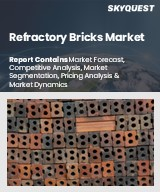
|
시장보고서
상품코드
1610680
시멘트 시장 규모, 점유율, 성장 분석, 유형별, 용도별, 지역별 - 산업 예측(2024-2031년)Cement Market Size, Share, Growth Analysis, By Type (Ordinary Portland Cement (OPC), Portland Pozzolana Cement (PPC)), By Application (Residential, Commercial), By Region - Industry Forecast 2024-2031 |
||||||
세계의 시멘트 시장 규모는 2022년에 3,268억 1,000만 달러로 평가되며, 2023년 3,434억 8,000만 달러에서 2031년에는 5,374억 3,000만 달러로 성장하며, 예측 기간(2024-2031년)의 CAGR은 5.1%로 성장할 전망입니다.
인구 증가로 인해 주택 건설 수요가 증가하면서 전 세계 시멘트 소비를 크게 늘리고 있습니다. 이러한 급증은 공공 인프라, 병원 및 의료 시설과 같은 비주거용 건축물에 대한 수요 증가로 인해 더욱 가속화되고 있습니다. 그러나 COVID-19 팬데믹으로 인해 시멘트 생산이 크게 중단되어 중국 같은 국가에서는 2020년 초에 시멘트 생산량이 8.2% 감소한 것으로 보고되었습니다. 이러한 좌절에도 불구하고 2020년 5월에는 8.6% 증가하며 회복세를 보이기 시작했습니다. 향후 세계 시멘트 시장은 인도, 말레이시아, 인도네시아 등 신흥 국가을 중심으로 교육 및 의료 분야의 인프라 수요 증가로 인해 성장할 것으로 예상됩니다. 하지만 시멘트 산업은 탄소 배출, 자원 고갈 등 환경 문제에 직면해 있으며, 이를 해결하기 위한 노력이 필요합니다.
목차
서론
- 조사의 목적
- 조사 범위
- 정의
조사 방법
- 정보 조달
- 2차 데이터와 1차 데이터 방법
- 시장 규모 예측
- 시장의 전제조건과 제한
개요
- 세계 시장 전망
- 공급과 수요의 동향 분석
- 부문별 기회 분석
시장 역학과 전망
- 시장 개요
- 시장 규모
- 시장 역학
- 촉진요인과 기회
- 억제요인과 과제
- Porter의 산업 분석과 영향
- 경쟁 기업 간 경쟁 관계
- 대체품의 위협
- 바이어의 교섭력
- 신규 진출업체의 위협
- 공급 기업의 교섭력
주요 시장 인사이트
- 주요 성공 요인
- 경쟁의 정도
- 주요 투자 기회
- 시장 에코시스템
- 시장의 매력 지수(2023년)
- PESTEL 분석
- 거시경제 지표
- 밸류체인 분석
- 가격 분석
- 기술의 진보
- 규제 상황
- 사례 연구
- 고객과 구매 기준 분석
- 무역 분석
- 원재료 분석
시멘트 시장 규모 : 유형별 & CAGR(2024-2031년)
- 시장 개요
- OPC(Ordinary Portland Cement)
- PPC(Portland Pozzolana Cement)
- 화이트 시멘트
- PBFSC(Portland Blast Furnace Slag Cement)
- 블렌드 시멘트
- 저탄소 블렌드 시멘트
- 기타 블렌드 시멘트
- 기타
시멘트 시장 규모 : 용도별 & CAGR(2024-2031년)
- 시장 개요
- 주택용
- 상업용
- 산업
- 기타
시멘트 시장 규모 : 지역별 & CAGR(2024-2031년)
- 북미
- 미국
- 캐나다
- 유럽
- 영국
- 독일
- 스페인
- 프랑스
- 이탈리아
- 기타 유럽 지역
- 아시아태평양
- 중국
- 인도
- 일본
- 한국
- 기타 아시아태평양
- 라틴아메리카
- 브라질
- 기타 라틴아메리카 지역
- 중동 및 아프리카
- GCC 국가
- 남아프리카공화국
- 기타 중동 및 아프리카
경쟁 정보
- 상위 5사의 비교
- 주요 기업의 시장 포지셔닝(2023년)
- 주요 시장 기업이 채택한 전략
- 시장의 최근 동향
- 기업의 시장 점유율 분석(2023년)
- 주요 기업의 기업 개요
- 회사 개요
- 제품 포트폴리오 분석
- 부문별 점유율 분석
- 매출의 전년대비 비교(2021-2023년)
주요 기업 개요
- Heidelberg Materials(Germany)
- Holcim Ltd(Switzerland)
- CEMEX S.A.B. de C.V.(Mexico)
- UltraTech Cement Limited(India)
- CRH plc(Ireland)
- Siam Cement Group(Thailand)
- Dangote Cement(Nigeria)
- Buzzi Unicem S.p.A.(Italy)
- Mitsubishi Materials Corporation(Japan)
- Titan Cement Company S.A.(Greece)
- Votorantim Cimentos(Brazil)
- InterCement Participacoes S.A.(Brazil)
- China National Building Material Co., Ltd.(China)
- Taiheiyo Cement Corporation(Japan)
- Asia Cement(Taiwan)
- Grupo Cementos de Chihuahua(Mexico)
- Eurocement Group(Russia)
- Martin Marietta(USA)
- Drake Cement LLC(USA)
- Argos USA LLC(Colombia/USA)
결론과 권장사항
KSA 24.12.30Global Cement Market size was valued at USD 326.81 billion in 2022 and is poised to grow from USD 343.48 billion in 2023 to USD 537.43 billion by 2031, growing at a CAGR of 5.1% in the forecast period (2024-2031).
Residential construction demand is on the rise due to population growth, significantly boosting global cement consumption. This surge is further fueled by the increasing need for public infrastructure and non-residential buildings, including hospitals and healthcare facilities. However, the COVID-19 pandemic severely disrupted operations and production, with countries like China reporting an 8.2% decline in cement output early in 2020. Despite these setbacks, recovery began with an 8.6% increase in May 2020. Looking ahead, the global cement market is poised for growth driven by rising infrastructure demands in education and healthcare, particularly in emerging economies like India, Malaysia, and Indonesia. Nevertheless, the industry faces environmental challenges, including carbon emissions and resource depletion, which need to be addressed as it expands.
Top-down and bottom-up approaches were used to estimate and validate the size of the Global Cement market and to estimate the size of various other dependent submarkets. The research methodology used to estimate the market size includes the following details: The key players in the market were identified through secondary research, and their market shares in the respective regions were determined through primary and secondary research. This entire procedure includes the study of the annual and financial reports of the top market players and extensive interviews for key insights from industry leaders such as CEOs, VPs, directors, and marketing executives. All percentage shares split, and breakdowns were determined using secondary sources and verified through Primary sources. All possible parameters that affect the markets covered in this research study have been accounted for, viewed in extensive detail, verified through primary research, and analyzed to get the final quantitative and qualitative data.
Global Cement Market Segmental Analysis
Global Cement Market is segmented by Type, Application and region. Based on Type, the market is segmented into, Ordinary Portland Cement (OPC), Portland Pozzolana Cement (PPC), White Cement, Portland Blast Furnace Slag Cement (PBFSC), Blended Cement (Low Carbon Blended Cement, Other Blended Cement), Others. Based on Application, the market is segmented into Residential, Commercial & Industrial, Others. Based on region, the market is segmented into North America, Europe, Asia Pacific, Latin America and Middle East & and Africa.
Driver of the Global Cement Market
The Global Cement Market is experiencing significant growth driven by an upsurge in construction activities fueled by an increasing need for residential spaces, including apartments and private homes, amid a rising population. As the demand for amenities in residential areas escalates, the cement industry is anticipated to expand rapidly. Additionally, the rising need for non-residential constructions, such as shopping malls, airports, factories, roadways, and office complexes, is expected to further propel market growth. Urbanization driven by job opportunities and improved living standards, along with government initiatives supporting construction and infrastructure development in emerging economies, will likely enhance demand for cement. Further, the increasing requirement for precast products like blocks, panels, and roof tiles is set to contribute positively to global cement consumption.
Restraints in the Global Cement Market
The global cement market faces significant constraints due to stringent government regulations aimed at controlling carbon emissions. The production of cement involves raw materials like limestone, chalk, shale, clay, and silica sand, but it also has detrimental effects on both the environment and human health. The inhalation of dust from the manufacturing process can cause respiratory issues, while the industry is a major contributor to pollution, ranking as the third-largest industrial polluter in the U.S. by the Environmental Protection Agency. Consequently, the implementation of various environmental regulations seeks to mitigate these adverse effects, ultimately hindering the growth of the cement market.
Market Trends of the Global Cement Market
The Global Cement market is witnessing a significant trend towards the adoption of green cement, driven by increasing demand for environmentally friendly and sustainable construction practices. This shift is bolstered by innovative carbon-negative manufacturing technologies that reduce emissions during production, aligning with global sustainability goals. As governments and construction firms prioritize eco-friendly solutions, the adoption of green cement is expected to enhance market growth prospects. This focus on sustainability not only mitigates pollution but also appeals to a growing consumer base that values environmentally responsible building materials, positioning green cement as a crucial segment in the future of the cement industry.
Table of Contents
Introduction
- Objectives of the Study
- Scope of the Report
- Definitions
Research Methodology
- Information Procurement
- Secondary & Primary Data Methods
- Market Size Estimation
- Market Assumptions & Limitations
Executive Summary
- Global Market Outlook
- Supply & Demand Trend Analysis
- Segmental Opportunity Analysis
Market Dynamics & Outlook
- Market Overview
- Market Size
- Market Dynamics
- Driver & Opportunities
- Restraints & Challenges
- Porters Analysis & Impact
- Competitive rivalry
- Threat of substitute
- Bargaining power of buyers
- Threat of new entrants
- Bargaining power of suppliers
Key Market Insights
- Key Success Factors
- Degree of Competition
- Top Investment Pockets
- Market Ecosystem
- Market Attractiveness Index, 2023
- PESTEL Analysis
- Macro-Economic Indicators
- Value Chain Analysis
- Pricing Analysis
- Technological Advancement
- Regulatory Landscape
- Case Studies
- Customer & Buying Criteria Analysis
- Trade Analysis
- Raw Material Analysis
Global Cement Market Size by Type & CAGR (2024-2031)
- Market Overview
- Ordinary Portland Cement (OPC)
- Portland Pozzolana Cement (PPC)
- White Cement
- Portland Blast Furnace Slag Cement (PBFSC)
- Blended Cement
- Low Carbon Blended Cement
- Other Blended Cement
- Others
Global Cement Market Size by Application & CAGR (2024-2031)
- Market Overview
- Residential
- Commercial
- Industrial
- Others
Global Cement Market Size & CAGR (2024-2031)
- North America, (Type, Application)
- US
- Canada
- Europe, (Type, Application)
- UK
- Germany
- Spain
- France
- Italy
- Rest of Europe
- Asia-Pacific, (Type, Application)
- China
- India
- Japan
- South Korea
- Rest of Asia Pacific
- Latin America, (Type, Application)
- Brazil
- Rest of Latin America
- Middle East & Africa, (Type, Application)
- GCC Countries
- South Africa
- Rest of Middle East & Africa
Competitive Intelligence
- Top 5 Player Comparison
- Market Positioning of Key Players, 2023
- Strategies Adopted by Key Market Players
- Recent Developments in the Market
- Company Market Share Analysis, 2023
- Company Profiles of All Key Players
- Company Details
- Product Portfolio Analysis
- Company's Segmental Share Analysis
- Revenue Y-O-Y Comparison (2021-2023)
Key Company Profiles
- Heidelberg Materials (Germany)
- Company Overview
- Business Segment Overview
- Financial Updates
- Key Developments
- Holcim Ltd (Switzerland)
- Company Overview
- Business Segment Overview
- Financial Updates
- Key Developments
- CEMEX S.A.B. de C.V. (Mexico)
- Company Overview
- Business Segment Overview
- Financial Updates
- Key Developments
- UltraTech Cement Limited (India)
- Company Overview
- Business Segment Overview
- Financial Updates
- Key Developments
- CRH plc (Ireland)
- Company Overview
- Business Segment Overview
- Financial Updates
- Key Developments
- Siam Cement Group (Thailand)
- Company Overview
- Business Segment Overview
- Financial Updates
- Key Developments
- Dangote Cement (Nigeria)
- Company Overview
- Business Segment Overview
- Financial Updates
- Key Developments
- Buzzi Unicem S.p.A. (Italy)
- Company Overview
- Business Segment Overview
- Financial Updates
- Key Developments
- Mitsubishi Materials Corporation (Japan)
- Company Overview
- Business Segment Overview
- Financial Updates
- Key Developments
- Titan Cement Company S.A. (Greece)
- Company Overview
- Business Segment Overview
- Financial Updates
- Key Developments
- Votorantim Cimentos (Brazil)
- Company Overview
- Business Segment Overview
- Financial Updates
- Key Developments
- InterCement Participacoes S.A. (Brazil)
- Company Overview
- Business Segment Overview
- Financial Updates
- Key Developments
- China National Building Material Co., Ltd. (China)
- Company Overview
- Business Segment Overview
- Financial Updates
- Key Developments
- Taiheiyo Cement Corporation (Japan)
- Company Overview
- Business Segment Overview
- Financial Updates
- Key Developments
- Asia Cement (Taiwan)
- Company Overview
- Business Segment Overview
- Financial Updates
- Key Developments
- Grupo Cementos de Chihuahua (Mexico)
- Company Overview
- Business Segment Overview
- Financial Updates
- Key Developments
- Eurocement Group (Russia)
- Company Overview
- Business Segment Overview
- Financial Updates
- Key Developments
- Martin Marietta (USA)
- Company Overview
- Business Segment Overview
- Financial Updates
- Key Developments
- Drake Cement LLC (USA)
- Company Overview
- Business Segment Overview
- Financial Updates
- Key Developments
- Argos USA LLC (Colombia/USA)
- Company Overview
- Business Segment Overview
- Financial Updates
- Key Developments



















